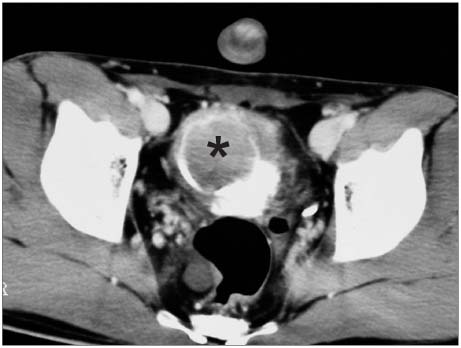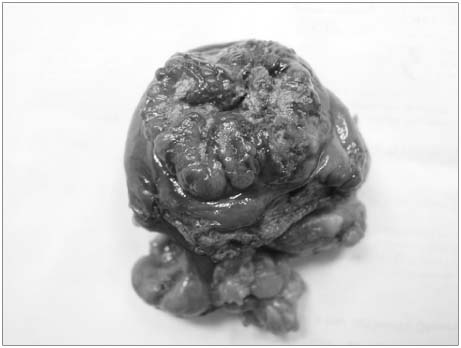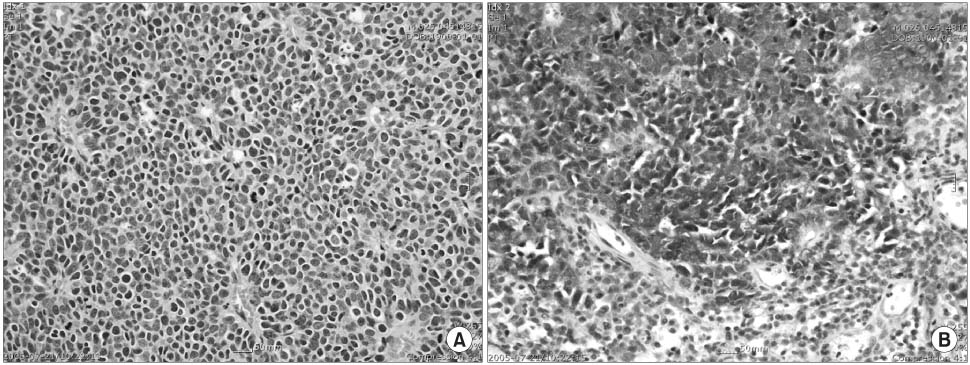Korean J Urol.
2006 May;47(5):556-558. 10.4111/kju.2006.47.5.556.
A Young Man with Primary Small Cell Carcinoma of the Urinary Bladder
- Affiliations
-
- 1Departments of Urology and Pathology, Chungbuk National University College of Medicine, Cheongju, Korea. wjkim@chungbuk.ac.kr
- KMID: 2294145
- DOI: http://doi.org/10.4111/kju.2006.47.5.556
Abstract
- Small cell carcinoma of the urinary bladder is a rare finding. It is characterized by an aggressive clinical course with early metastasis and it tends to affect the elderly who have significant comorbidities. The mean age of these patients is 67.8 years. The prognosis of small cell carcinoma of the urinary bladder is poor because its behavior is more aggressive than bladder transitional cell carcinoma. On the pathologic finding, small cell carcinoma of the urinary bladder is usually combined with transitional cell carcinoma or adenocarcinoma in approximately 40% of cases. We reported here on a case of the primary pure small cell carcinoma of the urinary bladder in a 26 year-old man who was managed with partial cystectomy and combined chemotherapy using cisplatin.
Keyword
MeSH Terms
Figure
Cited by 1 articles
-
Primary Neuroendocrine Carcinoma of the Urethra
Jun Nyung Lee, Dong Woo Lee, Young Su Kim, Ghil Suk Yoon, Jae Soo Kim, Eun Sang Yoo, Bup Wan Kim
Korean J Urol. 2008;49(3):284-286. doi: 10.4111/kju.2008.49.3.284.
Reference
-
1. Mackey JR, Au HJ, Hugh J, Venner P. Genitourinary small cell carcinoma determination of clinical and therapeutic factors associated with survival. J Urol. 1998. 159:1624–1629.2. Sung DJ, Lee JG, Cho JH. A case of small cell carcinoma of the urinary bladder. Korean J Urol. 1994. 35:1137–1141.3. Kato Y, Hasegaw Y, Wakita T, Hayashi N. A young patient with invasive small cell carcinoma of the urinary bladder. Hinyokika Kiyo. 2005. 51:287–289.4. Sved P, Gomez P, Manoharan M, Civantos F, Soloway MS. Small cell carcinoma of the bladder. BJU Int. 2004. 94:12–17.5. Choong NW, Quevedo JF, Kaur JS. Small cell carcinoma of the urinary bladder. The Mayo clinic experience. Cancer. 2005. 103:1172–1178.6. Podesta AH, True LD. Small cell carcinoma of the bladder. Report of five cases with immunohistochemistry and review of the literature with evaluation of prognosis according to stage. Cancer. 1989. 64:710–714.7. Mangar SA, Logue JP, Shanks JH, Cooper RA, Cowan RA, Wylie JP. Small-cell carcinoma of the urinary bladder: 10-year experience. Clin Oncol (R Coll Radiol). 2004. 16:523–527.8. Bex A, Niewenhuijzen JA, Kerst M, Pos F, van Boven H, Meinhardt W, et al. Small cell carcinoma of bladder: a single-center prospective study of 25 cases treated in analogy to small cell lung cancer. Urology. 2005. 65:295–299.
- Full Text Links
- Actions
-
Cited
- CITED
-
- Close
- Share
- Similar articles
-
- A Case of Primary Undifferentiated Small Cell Carcinoma of the Urinary Bladder
- A Case of Small Cell Carcinoma of the Urinary Bladder
- Cytodiagnosis of Primary Small Cell Carcinoma of the Urinary Bladder: A Case Report
- Small Cell Carcinoma of the Kidney in a Young Male
- An Elderly Female Non-smoker with Primary Small Cell Carcinoma of the Urinary Bladder




